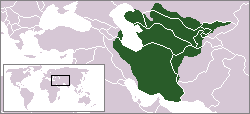Kuchlug
| Kuchlug Хүчлүг 屈出律 (Qū chū lǜ) | |
|---|---|
Taibuqa | |
| Religion | Nestorianism, then Buddhism |
Kuchlug (also spelled Küchlüg, Küçlüg, Güčülüg, Quqluq) (Mongolian: Хүчлүг; Chinese: 屈出律; d. 1218) was a member of the Naiman tribe who became the last emperor of the Western Liao dynasty (Qara Khitai). The Naimans were defeated by Genghis Khan and he fled westward to the Qara Khitai, where he became an advisor to his future father-in-law Yelü Zhilugu. He later rebelled, usurped the throne and took control of the empire, putting an end to the rule of the House of Yelü. He was killed in 1218 by the Mongols and the domain of the Qara Khitai was absorbed into the Mongol Empire.
While his predecessor Yelü Zhilugu was the last Qara Khitai emperor from the Yelü clan, Kuchlug is sometimes regarded as the final ruler of the Western Liao realm as he retained the dynastic title of "Great Liao" upon his ascension to the throne.[citation needed]
Naiman origins and westward flight
Kuchlug was the son of Taibuqa, the
The battle was a disaster for the Naiman. Jamuqa abandoned them and fled. Taibuqa was mortally injured, and his main commander was killed. The rest of the tribe surrendered to Temüjin and were absorbed into his ranks. Kuchlug managed to escape and with a few Naiman soldiers fled westward towards the
Afterwards Genghis Khan was wary of the threat Kuchlug still posed. In 1208, they again met in battle, and Kuchlug was pushed further west into Zhetysu. Reeling from a second defeat at the hands of the Mongols, Kuchlug turned to the Qara Khitai based in Balasagun for protection.

Qara Khitai
Kuchlug was welcomed by Yelü Zhilugu, the emperor of the Qara Khitai (Western Liao dynasty). Once he was accepted into the empire, Kuchlug quickly gained a strong foothold. He found service as an advisor for Yelü Zhilugu, and eventually married one of Yelü Zhilugu's daughters, Princess Hunhu (渾忽公主). He was later given the title of Khan, and was allowed to reorganize his fellow Naimans into a military unit under his command.[1]
Usurpation of the throne
Around that time, the Qara Khitai dynasty was dealing with rebellions in the east, as well as engaging in a struggle against
Yelü Zhilugu pulled back to his capital at Balasagun and defeated Kuchlug who retreated eastward to his Naiman realm. However, in 1211, while Yelü Zhilugu was out hunting, he was ambushed and captured by Kuchlug. The Khwarezm-Shah then joined Kuchlug in capturing the Qara Khitai. Yelü Zhilugu was made taishang huang and Kuchlug became emperor of the realm.[2] Many historians consider Kuchlug's usurpation of the throne in 1211 to be the end of the Qara Khitai, although the realm (which retained the official name of "Great Liao") would not fall until 1218.[3]

Conflicts with Muhammad II
Once Kuchlug had established himself as ruler, Muhammad demanded the Qara Khitai Gur-khan to be handed over and a princess as a reward for his previous support. Kuchlug tried to stall, but eventually Muhammad became more aggressive. However, when Kuchlug threatened to resolve the rivalry by direct combat, Muhammad chose to evacuate the region of upper
Religious policy
Kuchlug was from the Naiman tribe, which were
Downfall and death
Kuchlug attacked the city of
See also
- Mongol invasion of Central Asia
References
- ^ ISBN 0521842263.
- ISBN 978-0195338195.
- ISBN 0521842263.
- ISBN 0521842263.
- ^ Ata-Malik Juvayni (1958). The History of The World Conqueror. Harvard University Press.
- ^ Ata-Malik Juvayni (1958). The History of The World Conqueror. Harvard University Press.
- ISBN 0521657040.
- ISBN 0521842263.
- ISBN 0521842263.
- ^ Ata-Malik Juvayni (1958). The History of The World Conqueror. Harvard University Press.
- ^ Yuan Shi Chapter 120
- OCLC 1022078179.)
{{cite book}}: CS1 maint: location missing publisher (link) CS1 maint: multiple names: authors list (link
Further reading
- Ata-Malik Juvayni (1958). The History of The World Conqueror. Harvard University Press.
- Christian, David. A History of Russia, Central Asia, and Mongolia. (1998)
- de Hartog, Leo. Genghis Khan: Conqueror of the World. (1989)
- Biran, Michal. The Empire of the Qara Khitai in Eurasian History: Between China and the Islamic World (2005) Cambridge University Press, ISBN 0521842263
